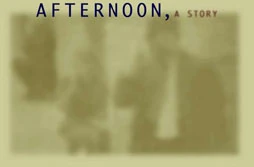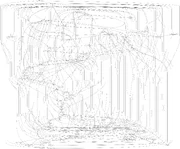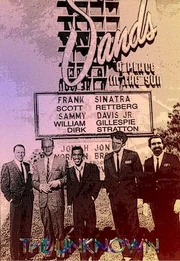Hypertext fiction is a genre of Electronic Literature which is made up of non sequential and interlinking lexia.
History[]
The history of hypertext fiction dates back to even before the World Wide Web was created. In 1987, English Professor Michael Joyce wrote what is considered the first hypertext fiction piece titled afternoon, a story.

Michael Joyce's "Afternoon, a story"
During the time, most hypertext fiction pieces were written in softwares such as Storyspace and Hypercard, which were programs specifically used for the creation and viewing of hypertext fictions.[1] Currently, almost all hypertexts fictions are written in the HTML language.
The company who published Michael Joyce's piece was Eastgate Systems and they continued to follow the trend of hypertext fiction with a series of several other pieces including Sarah Smith's The King of Space and Stuart Moulthrop's The Victory Garden. While Eastgate systems continued to churn out several hypertext fictions, a phenomenom known as the World Wide Web became open and free to the public in 1993.[2] This system of interlinked documents provdided a tool for writers to share their hyptertext fiction pieces with individuals all over the web. The first hypertext fiction novel published on the World Wide Web was Robert Arellano's Sunshine 69, where the user explored through a nonlinear calendar of scenes. The trend of hypertext fictions continued throughout the World Wide Web and was further showcased through the creation of the Electronic Literature Organization(ELO) which promoted the creation of electronic literature. Probably the most noteworthy example of hypertext fiction was created in 2001 by Caitlin Fisher titled, These Waves of Girls', which won the ELO's award for fiction in 2001.[3]
Shortly after 2001, the trend of hypertext fictions began to fall and not many pieces were published. With technology further evolving and the rise of e-books, one would think that hypertext fiction would flourish today. While no one is sure why this fall off occured, novelist Paul LaFarge offers a good explanation in his article, Why the book's future never happened, stating that the genre of hypertext fiction is not viable and they are generally very difficult to write.
Language[]

Map of "These Waves of Girls"
The language used in Hypertext Fiction targets not just the reader, but also the computer. Without extra information, the computer has no way of knowing how the author would like to display the text. The necessary information for presentation is provided in Hypertext Markup Language (HTML ) and permits the browser to display text with formatting (paragraphs, lists, etc) and perform operations in reaction to user input (links, videos, etc). Links are especially important for Hypertext Fiction as they form the foundation for the interconnected lexia. In this way, HTML is not only used to describe the author's meaning of the story, but also the shape of the story. HTML is a standardized language and it's specification calls it "the publishing language of the World Wide Web" [4]. The existence of an agreed upon language makes the Web the accessible platform it is.
Examples[]
There are many different examples of hypertext fiction and they all tell a story through various lexia.

Opening page of Shelly Jackson's my body - a Wunderkrammer
Shelly Jackson's my body - a Wunderkammer[]
Shelly Jackson describes my body - a Wunderkrammer as a "semi-autobiographical hypertext combining text and image in an exploration of the body". This piece was created in 1997 and includes illustrations and sound [5]. The opening interface of the piece is the body of a naked girl, the user can then navigate the lexia by clicking on various parts of the body. When the user clicks on parts of the body they are taken to another page that describes that body part. The descriptions go beyond physical details, they include stories about those body parts and how exploring them makes her the person she is today. Most of the pages include rough sketches of the body part the story is about, which offers the user a visual to go with the stories. Jackson entices the user to wonder through the body by placing links where there is no obvious reason to click there, like the brain area.
Since my body - a Wunderkrammer is a piece of hypertext fiction there is no right or wrong path to take through the lexia. The body parts lead to stories that are filled with multiple links that can take the reader to stories about other body parts. my body - a Wunderkrammer benefits from being hypertext fiction because it allows the user to explore the body in any manner they choose, just like the author.
Shelly Jackson is also known for Girl Patchwork Girl another piece of hypertext fiction.
Caitlin Fisher's These Waves of Girls[]
These Waves of Girls by Caitlin Fisher is a very large web of lexia that goes through a girl's memories of her past. These Waves of Girls has stories about sexual identification, friendship, and adventures. When first opening These Waves of Girls there are eight different catergories: kissing girls, school tales, I want her, city, country, she was warned, dare, and her collection. Each catergory has its own subcatergories and the story themselves have links to other stories in them. Fisher uses picures to assist her stories, but some of the pictures are cut off or zoomed in making it hard to understand them. This picture detail play into the memory aspect of the stories, suggesting these are just bits and pieces of full stories. The stories are all also visually formatted in different ways, some are in "normal" in line paragraphs, sometimes the paragraphs are in alternating columns, or sometimes the user is required to click through a story. Some stories have audio and can be listened to.

Example picture from These Waves of Girls
These Waves of Girls takes advantage of hypertext fiction with its many lexia, pictures, and audio. This elements assist the user by making process more personal becaause there are many different ways to experience the piece.
Comparison To Other Electronic Literature[]
In hypertext fiction the reader does not follow a set path through the literature and is therefore able to control what hyperlinks to follow. Another factor in hypertext fiction is that there can be multiple links to follow within each new page which sometimes link to a page that the reader has already visited.

The Unknown a classic hypertext fiction piece
Therefore resembling interactive fiction where the reader is no longer strictly a reader but an interactor. While hypertext fiction uses links to dig deeper into a story, interactive fiction utilizes text based gameplay that requires the user to figure out the next appropriate step. In interactive fiction, which falls under computer games , it is very likely that the interactor may get stuck and not be able to complete the full story. An evolution of interactivity between interactor and literature is locative narratives where the narrative changes based on geographical location[6]. Another form of electronic literature is blog fiction that is a continuing series of stories in diary form that are written over time by the fictional character(s). If the fictional author is blog aware then there may be some interaction between the reader and the story line but there may be direct interaction between reader and author.
Compare:
My Body (Hypertext Fiction) to Shade (Interactive Fiction)
Postmodern Aspects[]
Hypertext fiction operates within the postmodern context through its adherence to several key aspects of the literary genre. 1) The intertextual nature of of hypetext fiction allows authors to build upon the lexicon of previous texts in a way that permits them to challenge and redefine traditional literary themes. 2) There is a shared authorship between reader and writer, made possible by the multiple pathways of the hypertext links. 3) Hypertext fiction takes as its subject art itself, in the fashion of "meta-criticism." 4) The multiple pathways render linear notions of narrative impossible. 5) It takes in its subject the pervasive use of irony/commedy. 6) Finally, hypertext fiction takes on the postmodern concept of blurring the distinctions of "high" and "low" culture.

Demonstrates pastiche, confounding "high" and low "culture" in painting form
Postmodernism can be described "as an avant-garde movement calling into question not only particular literary practices but also more genrally held beliefs about the value of representation, whether in art or in critical and philosophical discourse, as well as about the capcity of language itself to represnet "reality" in any ultimately trustworthy way."[7]
1) Many hypertext fiction pieces, operate almost as a pastiche, or callage, using the works of others to create an overall new piece of work. Walter J. Ong , speaks about how intertextuality is a vibrant part of postmodernism because, in this globalized culture, coming up with a new way of telling a story becomes difficult. Hypertext fiction pieces, such as "These Waves of Girls" remix the romantic tradition of the Bildungsroman genre, by speaking about personal growth and developmetn in a new way.
2) A hypertext fiction piece will be different for everyone who reads it. This is because of the various hypertext links that create multiple ways of reading the same story. There is no fixed path, and the reader must continue to the story, and make decisions based on their own interests and perceived connections.
3) The disjointed structure that characterizes hypertext fiction, and the inclusion of various methods of visual and auditory stimulatoin, create a meta-criticism, that takes art itself as its subject. Stories such as Shelley Jackson's "my body," that call attention to the fact that the whole piece is to be looked at as a piece of art.
4) The multiple pathways associated with the hypertext links, as spoken about above, is very characteristic of the postmodern novel's non-linear narrative structures. Hypertext fiction even goes beyond what print literature can do with this, by giving every person a unique experience with the work in question. Since postmodernism takes into account any writers ability to portray reality in a truthful, hypertext links allow for a gradual accretion of knowledge, opposed to an author who dictates meaning and patterns.
5) In a culture that is perhaps disillusioned by complexity and the hybridity of human and technology, postmodern literature often uses irony as a way to address societal norms. "This comic view extends even to the ambitions and authority of literature that the fragmentaion, distortion, parody, and strategic deconstruction of tradition form amount to a comic reduction of 'serious' fiction to a level where...it might be regarded more as an always renewable resource rather than as an already completed model to be emulated."[8]
6) The interlacing of "high" and "low" culture often addressed in postmodern literature, effectively blurring or erasing the lines between the true, is a theme that is evident in hypertext fiction. For example, Shelley Jackson's "Girl Patchwork Girl," creates a story based on the female monster in Mary Shelley's "Frankenstein." This incorporation of a literary classic into a genre that is so "mass" produced, that it can be found on any lab top, truly summarizes this blurring notion of postmodern literature.
Sources[]
- ↑ "Enhancing the understanding of genres of web-based communities" by J. Bishop
- ↑ "A Little History of the World Wide Web" by R. Cailliau
- ↑ "The 2001 Electronic Literature Awards"
- ↑ HTML 4.01 Specification
- ↑ http://collection.eliterature.org/1/works/jackson__my_body_a_wunderkammer.html
- ↑ http://eliterature.org/pad/elp.html
- ↑ Green, Daniel. Postmodern American Fiction. The Antioch Review, Vol. 61, No. 4, Circuses and Art Museums (Autumn, 2003) pp. 729
- ↑ Green, Daniel. Postmodern American Fiction. The Antioch Review, Vol. 61, No. 4, Circuses and Art Museums (Autumn, 2003) pp. 733
Numbered sources
